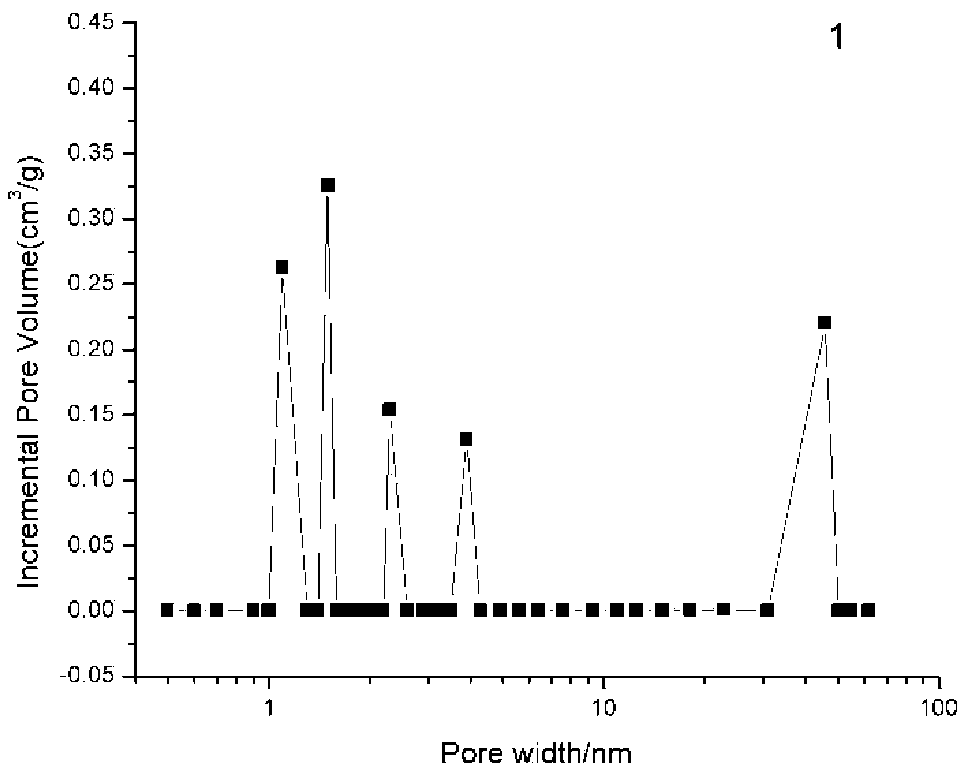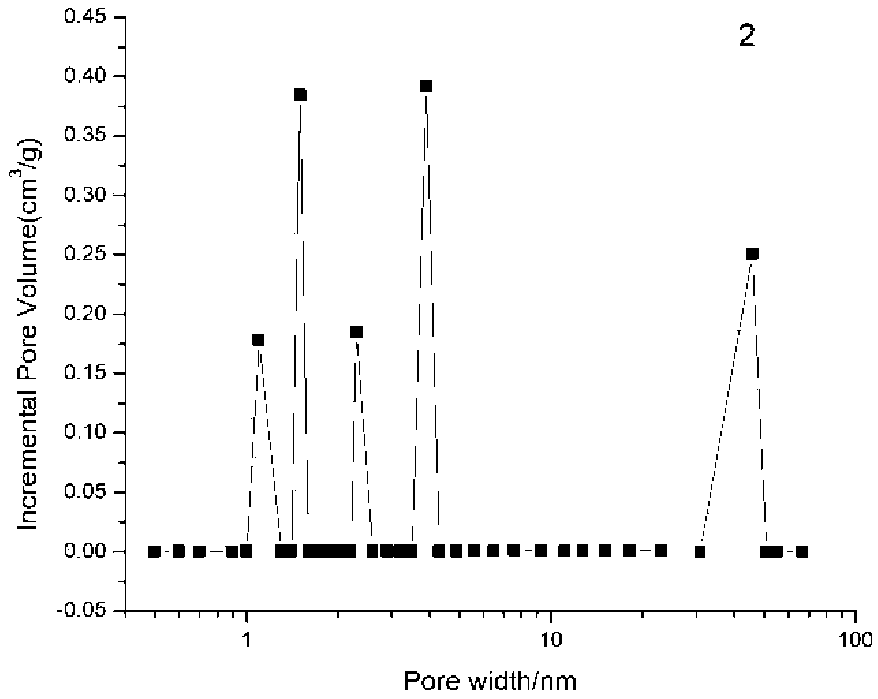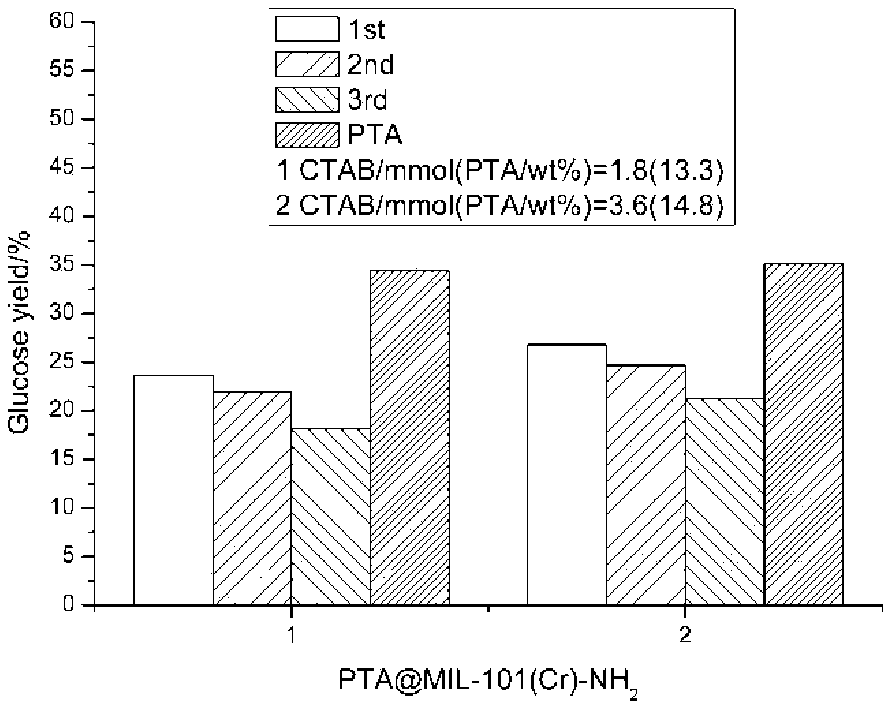Synthesis method of mesoporous-microporous Cr-MIL-101 carrier capable of realizing synchronous immobilizing of phosphotungstic acid
A synthesis method and phosphotungstic acid technology, applied in the field of materials, can solve problems such as limiting the application of PTA, and achieve the effects of simple preparation process and high material yield
- Summary
- Abstract
- Description
- Claims
- Application Information
AI Technical Summary
Problems solved by technology
Method used
Image
Examples
Embodiment 1
[0020] The meso-micro-double-porous Cr-MIL-101 material with simultaneous immobilization of phosphotungstic acid was prepared by the following method: 45 mL distilled water, 6.0 mmol Cr(NO 3 ) 3 ∙9H 2 O, 0.3 mmol PTA, 6.0 mmol 2-aminoterephthalic acid, and 1.8 mmol CTAB were stirred evenly at room temperature, then added to a 100 mL polytetrafluoroethylene reactor, heated at 150 °C for 12 h, cooled to room temperature, and then used The solid obtained after repeated washing and centrifugation with DMF and ethanol was vacuum-dried at 80 °C for 16 h, and the obtained solid was the meso-microbiporous Cr-MIL-101 material with synchronously immobilized phosphotungstic acid.
Embodiment 2
[0022] The meso-micro-double-porous Cr-MIL-101 material with simultaneous immobilization of phosphotungstic acid was prepared by the following method: 45 mL distilled water, 6.0 mmol Cr(NO 3 ) 3 ∙9H 2 O, 0.3 mmol PTA, 6.0 mmol 2-aminoterephthalic acid, and 3.6 mmol CTAB were stirred evenly at room temperature, then added to a 100 mL polytetrafluoroethylene reactor, heated at 150 °C for 12 h, cooled to room temperature, and then used The solid obtained after repeated washing and centrifugation with DMF and ethanol was vacuum-dried at 80 °C for 16 h, and the obtained solid was the meso-microbiporous Cr-MIL-101 material with synchronously immobilized phosphotungstic acid.
[0023] The pore size distribution figure of embodiment 1~2 gained material is as follows figure 1 with figure 2 As shown, it can be seen that the products added with CTAB all have a meso-micro biporous structure, wherein the material pore size distribution obtained in Examples 1~2 is 1.1~46 nm, and the mes...
Embodiment 3
[0029] The application of the meso-micro-double-porous Cr-MIL-101 material that simultaneously immobilizes phosphotungstic acid includes the following steps: adding 0.12 g of the meso-micro-double-porous Cr-MIL-101 that simultaneously immobilizes phosphotungstic acid to 10 mL of distilled water material or pure PTAx g with the same amount of PTA immobilized in the meso-micro-biporous Cr-MIL-101 material of 0.12 g synchronously immobilized phosphotungstic acid, and 0.04 g microcrystalline cellulose was added at the same time, and kept at a constant temperature of 180 °C Heated and stirred continuously for 11 h, and centrifuged after the reaction. The solid residue precipitated at the bottom of the centrifuge tube after centrifugation is the large-pore metal-organic framework material of immobilized PTA used to catalyze the hydrolysis of microcrystalline cellulose after the reaction, which can be washed with distilled water and dried at 80 °C for 16 h. reuse.
[0030] Cr 3+ : ...
PUM
 Login to View More
Login to View More Abstract
Description
Claims
Application Information
 Login to View More
Login to View More - R&D
- Intellectual Property
- Life Sciences
- Materials
- Tech Scout
- Unparalleled Data Quality
- Higher Quality Content
- 60% Fewer Hallucinations
Browse by: Latest US Patents, China's latest patents, Technical Efficacy Thesaurus, Application Domain, Technology Topic, Popular Technical Reports.
© 2025 PatSnap. All rights reserved.Legal|Privacy policy|Modern Slavery Act Transparency Statement|Sitemap|About US| Contact US: help@patsnap.com



